Page D
(The Study of Threes)
http://threesology.org
This page is a companion to the following links:
- Evolutionary 3s page A
- Evolutionary 3s page B
- Evolutionary 3s page C
- Evolutionary 3s page E
- Evolutionary 3s page F
3 researchers, Rebecca L. Cann~ Mark Stoneking~
Allan C. Wilson,
used information derived from mtDNA (mitochondral
DNA) to propose that our earliest human ancestors arose in Africa to which was
applied the notion of The African Eve. There are 3 overall general results
of their research:
All humans come from a single stock.
Genetic complement of Africans is unique. Africans are more different from other humans than those other humans are from each other.
The rest of modern humans are divided into two main groups, one including Europeans and Northern Asians, the other including Southern Asians...(hence, we are left with 3 overall groups.)
3 reasons some researchers consider that Homo neanderthalensis are more animal than human:
They do not recognize the evidence for art, music, shelters, clothing or caring for the dead.
They believe that objects found in burial sites occurred by chance.
They accept the idea that the species had more advanced tools, but did not know how to use them, resulting in many injuries.
3 samples of mtDNA from separate individuals shows that the Neanderthal is outside the range of genetic compatibility with modern humans, giving a clear indication that Neanderthals could not/did not inter-breed with those that would later evolve into present humans.
|
Some people consider that there are no present day living forms of early types of hominids, while others consider that there are three frequently cited areas where examples of earlier ancestors now live:
- Pacific Northwest of North America (Big Foot)
- Himalayas of Tibet (Abominable Snowman)
- Nepal in Asia (Yeti)
While there are reports of sightings of "hairy man-like" creatures from other parts of the world, and that some areas may use the same (or different) name to reference what may appear to be the same or similar creature, the three aforementioned examples are particularly well known.
It should be of some interest to those actively involved in the pursuit of hunting for fossil remains of humans to consider that humans may "instinctively" seek out some representation of a triangular shape. If not in the fashioning of triangular-shaped tools, then by migrating in, along, or towards an area where there exists (or existed) some triangular- shaped terrain... unless in some instances the triangular-shape was interpreted as a "bad sign," whereby the early hominids would have moved away from such an area which represented this image. The shape of the triangle may not be the traditional one, but be of an inverted type, as seen from the height of the hominid in question. In other words, the presence of human fossil remains in the Afar Triangle region may not be a coincidence. (Do the legendary creatures such as Big Foot, Yeti, etc., gravitate towards or away from triangular-shaped geological formations, trees, etc.?
A triangular-shaped tree, rock, ravine, etc., may have held some especial point of (unconscious/sub-liminal) cognitive reference for early hominids in a particular region, which presents us with the idea that there may have been particular individuals amongst a species who were more intelligent then their peers. An above-average intelligent individual, in terms of the mental capacity of any particular early hominid, would likely have viewed events in the world in a different fashion than others. They may have mated, hunted, and reared children differently than their nearest neighbors. Such "advanced thinkers" may have been somewhat privy to ideas or illusions thereof, which would later become Commonplace~ Taken-for-granted ~ "Common-sense" notions of later humans such as the forth-coming usage of the triangle image to design huts, tepees, pyramids, etc...
If this is true, that early hominids did gravitate to some point of triangular reference in the environment as opposed to incorporating such into their tools, whether the triangle image is upright, inverted, etc., then it may be valuable to search for more fossil remains in those regions which exhibit triangular configurations. Then again, it may be valuable to consider which present day terrains once exhibited triangular configurations long ago, but do not do so today. In any respect, we must attempt to put ourselves in the frame-of-mind of an early ancestor that may have stood no more that 3 feet tall. Instead of using a bird's eye view to scope the terrain, we must use a child's point of view that may be no more than 3 feet off the ground. Perhaps researchers should invite children, midgets, or pygmies along to spot triangular terrain configurations. However, we come to the question of what degree of cognitive development did an early form of hominid have? Not in terms of words, symbols, or configurations thereof today, but which would represent some degree of a Linear~ Circular~ Triangular basis that we of today could readily discern in our modern sense.
Traditionally, peking man has been depicted as a cave dweller who had mastered the arts of:
- Stone tool manufacturing
- Hunting
- Building (making) fires.
Anthropology, as well as religion and other ideas, is said to be complicated by the presence of Misquotes~ Hoaxing~ Lunatic fringe activities.
Three stratigraphic subunits of the
Bouri Formation:
Herto, Daka and Hata. (Australopithecus garhi
(garhi means "surprise") discoveries come from Bouri, in the Middle Awash area
in the Afar desert of Ethiopia, about 70 km. south of the Lucy A. afarensis
discovery at Hadar.)
http://www.jqjacobs.net/anthro/paleo/garhi.html
3 places Homo erectus is believed to have lived until about 200,000 years ago: Africa~ Asia~ Europe.
Some researchers actively participate in attempting to circumvent the work of other researchers by claiming to find Mistakes, Illusions, or Hoaxing involved in discoveries. It becomes an applied self-made career pursuit by attempt to discredit another's or others work by suggesting they failed to keep the Nature ~ Methods ~ Limits of knowledge in mind... thereby gaining notoriety for a personal achievement in a field they themselves have otherwise made no real contribution in or to. They use the tools of their profession for attempts to rally public opinion in their favor by persuading the public's naivete to accept that any information concerning the past is Complex ~ Incomplete ~ and Largely inaccessible.
Scientists claim their work is often misinterpreted by scientifically uneducated people who report their interpretations in Popular books ~ Magazines ~ Newspapers. (If we include Television ~ Radio ~ Internet, we have another group of three.)
Many people feel that when they are asked to give opinions about dubious subjects, it is best to exhibit Silence ~ Philosophic doubt ~ Or unsettled conviction.
Generally speaking, science of today is considered to be superior in Thoroughness ~ Concept ~ Methodology, than the science of a hundred years ago.
3 actions are often suggested to be the reason for marks, breaks, etc., found on bones:
- Aquatic life forms such as sharks
- Terra life forms such as hyenas, wolves, etc.,
- Geological processes.
In another interpretation, some marks found on bones are considered to be due to a slightly different trio: Humans ~ Animals ~ Geological forces.
3-patterned phrase that has been associated with the analysis of an analysis of an analysis: A Definitive- Debunking- Report
3 in 1 combined result of Wear ~ Decay ~ Parasites have sometimes been interpreted as having caused the marks on shark teeth.
It has been considered that stone tools leave V-shaped cuts, that are narrower than rodent gnawing marks. It is because of their irregular edges that cutting instruments of stone generally leave small striations along the longitudinal axis of the V-shaped grove.
3 types of indications are sometimes primarily representative of marks on bones, molluscs, etc.,: Fluted ~ Engraved ~ Grooved
3-patterned (progressive?) design appearance in overall development of stone tools that can be characterized as:
- Monofacial {unifacial - Linear-like)... simple sticks
- Bifacial - (Circular-like)... palm fitting "round" rocks
- Trifacial {triangular}- (Triangular shapes)... frequently attached to a "handle"
In attempting to fashion some semblance of evolutionary usage to the above three forms, we can imaginatively "see" a stick being used to unearth a partially embedded rock that is used to hammer another stone into an object that may already have a crude triangular shape that becomes attached to the stick. Hence, all three are used to make one tool/weapon.
As a reference to the 3 to 1 ratio idea, see:
http://www.threesology.org/321-a.php
For a list of other Linear - Circular- triangular configurations, see:
http://www.threesology.org/evolutionary-3s-b
Three different late Middle Pleistocene tool traditions are generally recognized by archaeologists:
The Chopper/Chopping-too tradition of eastern Asia continued the Early Pleistocene tradition of crude choppers and simple flake tools.
The Flake tradition, found in parts of western Europe and northern Africa, was not greatly different, but laid greater emphasis on small cutting and scraping tools rather than on heavy-duty chopping tools.
The Biface tradition was by far the most important, widespread, and technologically sophisticated of the three. It spread throughout Africa, western and southern Europe, and southern Asia as far as India. The most typical tools, from which the tradition derives its name, were large pointed "hand axes" chipped on both faces.
Above tool information from page 42, The Columbia History of the World, edited by John A. Garraty and Peter Gay. ©1972 by Harper & Row, Publishers, Inc. ISBN 0-88029-004-8
This is a selection of Mousterian (Neanderthal) tools made of chert, a quartz material similar in working properties to flint, found in the Shanidar cave.
|
 --- The Clan Cave --- http://www.hominids.com/donsmaps/clancave.html Original photo: Dr Ralph Solecki |

Triangular, hand-sized chunk of ochre and purple rock with a slightly scratched surface (called Excalibur), was found among ancient bones in a cave at Atapuerca, near the city of Burgos in central Spain. (01-09-02) It is thought by some to represent a key moment in the evolution of man's mind, at a time well before our own race, Homo sapiens, reached Europe.
The rock (tool) is claimed to be the oldest evidence of human creativity: a 350,000-year-old pink stone axe. Spanish researchers found the axe among the fossilised bones of 27 ancient humans that were clumped together at the bottom of a 14-metre- (45 feet) deep pit inside a network of limestone caves. The handaxe is considered by some to represent the first funeral rite by human beings. Its shape and color suggests humans were capable of symbolic thought at a far earlier date than previously thought.
Information and image sources:
http://www.guardian.co.uk/international/story/0,3604,871235,00.html
--- Evidence of earliest human burial ---
http://news.bbc.co.uk/2/hi/science/nature/2885663.stm
However, we must ask whether the stone 'tool' is representative of "intentional symbolic thought," or is merely an example of a triangular-type of "mindless doodling" that reflects an unintentionally expressed mental impression of a triangular-shaped environmentally- influenced biological event such as the triangular passage of the Sun and/or moon that may have acted as a type of branding iron effect on the human brain (as well as influencing triangular-shaped pyramidal cells?). Are we to say that early hominids did not "doodle" because such an activity is a modern behavior? Is it not possible that what we of the present ascribe to as creativity, abstract and intentional "smartness" is nothing more that an artifact of an accidental creation that is similar to a highly unexpected serendipitous event in the laboratory, garage, garden, workshop, drawing table, writing desk, etc., that perhaps is not recognized as being of any significance till a later period by someone else?

3 characteristics of the Venuses of Willendorf, Lespugne, Laussel:
- Pouching Bellies.
- Huge Breasts.
- Rotund buttocks.
You will notice the word "fat" is infrequently used. And
speaking of fat, it has been suggested that these figurines are a type of
prehistoric recognition of the link between fat and fecundity, because it is
considered that low body fat, in a woman, retards births.  Is it a
coincidence of similarity that the brain of an early human which fashioned this
figurine can be seen by today's children in which snowman figures exhibit Rotund
bottoms and pouching bellies/chests, all of which are incrementally sized and
topped with a large proportioned head? And from another perspective, a
person sitting behind two tom-toms and 1 base drum is another connotation to the
Venus of Willendorf.
Is it a
coincidence of similarity that the brain of an early human which fashioned this
figurine can be seen by today's children in which snowman figures exhibit Rotund
bottoms and pouching bellies/chests, all of which are incrementally sized and
topped with a large proportioned head? And from another perspective, a
person sitting behind two tom-toms and 1 base drum is another connotation to the
Venus of Willendorf.
http://www.hominids.com/donsmaps/willendorf.html
FONT color=#ff0000>3 separate theories for the Pleistocene extinctions are being argued in the field of Paleoarcheology and paleozoology:
Ernest L. Lundelius Jr. & Russell Graham's theories that drastic shifting in climates dissolved ancient animal ecological alliances, thus destroying individual species over a protracted period of time--13000-8000 years ago.
Ross D. E. MacPhee and Preston A. Marx's radical new theory that hyper-disease attacked the new world, jumping from species to species in a pandemic analogous to the plagues of Medieval Europe or the Spanish Influenza pandemic of 1918 which killed between ten and forty percent of the population in various communities. In their model, the disease killed not all, but just 35 to 65 percent of it's victims. The surviving populations were weakened, ravaged, and had suffered a number of side effects causing them to be malnourished and for their reproductive rates to fall dramatically. It is postulated that when the mortality rate from all combined factors rises above 75 percent, populations tend to be so completely stressed that random environmental occurrences, including human hunting and weather changes, might finish off the last survivors by preventing them from further reproduction.
Paul S. Martin's current theory compiled from over 200 years of research and argumentation: A "Blitzkrieg" of Human hunters exploding across the continents, who over-hunted and decimated large species in a manner similar to what the Caucasian North American settlers did millennia later to the vast bison and pronghorn antelope herds.
http://www.alienufoart.com/Cryptozoology.htm
The Greenberg/Turner Evolutionary triangle hypothesis, although controversial, has great appeal for some, because it synthesizes so many independent lines of evidence. And no matter what one was comparing-languages, teeth, or genes-the magic number was three. (Is the "Great Appeal" due to an underlying triangle image imprinted on the human psyche, for the triangle image expressed by the path of the Sun from dawn to noon to dusk?)
The following image is of the Moon in eclipse, though the picture could just as easily be a picture of the Sun. I inverted the picture in order to show the complete pathway of ascent and descent. This is an actual picture taken from page 80 of the 10/97 issue of Natural History magazine.
 |
 |
The usage of time-lapsed photography gives us some indication of the environmental conditions early biological life processes were subjected to many billions of years ago when the Earth was spinning faster. Early biological processes would have been subjected to a repeating triangular image for long periods of time. It should be no wonder that we find this image being expressed in a variety of ways by different organisms, within the limitations of their physical/mental ability to do so. If we humans of today can get sun-burned, it's not too difficult to appreciate how such a triangular image could have been "branded" on the sensitive, impressionable, (highly "suggestive") "hide" of our early biological beginnings. As a child, I would get the image of standing on a fast spinning Earth and watching the Sun, Moon, and Stars whisk by in a flickering (blinking) motion.
This picture clearly shows that there is a triangular pathway. The usage of time-lapsed photography to capture the slanted (triangular) path gives a good indication of how a fast spinning Earth during life's pristine biological development helped to create different environmental conditions. Some three and a half to four/five billion years ago, the Earth's rate of daily revolution was considerably faster than our present 24-hour rate. This accelerated rate would have caused the triangular image to occur more frequently during life's sensitive and impressionable development. If we humans of today can get sun-burned, it's not too difficult to appreciate how such a triangular image could have been "branded" on the "hide" of our early biological beginnings. But let us now consider what other effects could have been produced by an accelerated spinning Earth.

The above image was adapted from:
http://www.umass.edu/sunwheel/
...and you can find a link for the original on this page at the Sunwheel logo:
http://solar-center.stanford.edu/folklore/folklore.html
There are three linguistic groupings to the idea that the Earliest Americans came from Asia in one, two, or three waves:
- Amerind (spoken by American Indians).
- Eskimo-Aleut (spoken by Eskimos and Aleutian Islanders).
- Na-Dene (spoken by people of the Northwest coast of Canada and the United States).
Three types of molar shapes and three genetically distinct populations were also found. "Every time you come around, it's three," says Arizona State University bioarchaeologist Christy Turner.
Adapted from:
http://www.unl.edu/rhames/courses/greenberg.htm
3 examples of Hierarchical Groups:
| [1] MONOPHYLY: each monophyletic group contains all the descendants of a common ancestor (each group has a common ancestor unique to itself). |
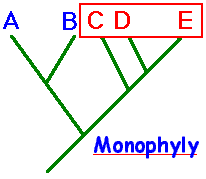 |
| [2] PARAPHYLETIC: includes some but not all descendants of a common ancestor (this is usually a group of taxa that share an ancestral state, and excludes taxa that have diverged with derived character states). |
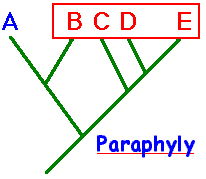 |
| [3] POLYPHYLETIC: include taxa that do not share a common ancestor-- share convergently derived character states (i.e., homoplasies). |
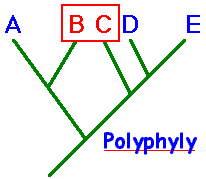 |
Phylogenetic Reconstruction Link: http://www.bio.indiana.edu/Courses/S318-Brodie/S318/S318lect24-systematics.html
3 to 1 ratio presentation:
 |
 |
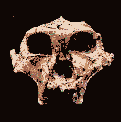 |
 |
| A. Afarensis | A. Africanus "cousin" |
A. Robustus "cousin" |
A. Boisei "cousin" |
The three Australopithicines--("Southern Apes") erect-walking, ape members of the hominid family (on the right) are said to be contemporaries of the earliest human species. These three Australopithicines species are regarded as "cousins" to present humans rather than ancestors. However, the most ancient of the ape hominid species shown here, A. afarensis at left, is often regarded as ancestral to both humans and the other Australopithicines.
http://www.wsu.edu:8001/vwsu/gened/learn-modules/top_longfor/overview/Overvw6.html
3 evolutionary ---
Solutions to Flight
--- as an example of convergent evolution among
vertebrates:
| [1] The first vertebrates to evolve true flight were the Pterosaurs, (flying archosaurian reptiles). 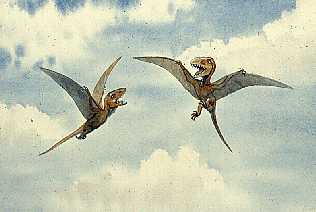 --- Pterosaurian Flight --- |
[2] The most diverse group of flyers ever to evolve are the birds. 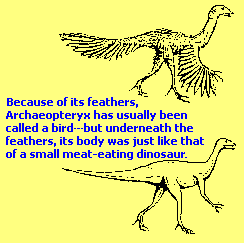 --- Dinosaur National Monument --- |
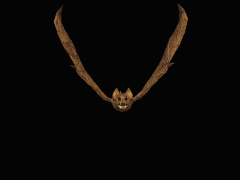 [3] [3]
The Chiroptera, or bats, are the second most diverse group of mammals, and are the only mammals ever to evolve true powered flight. --- Chiropteran Flight --- Image source: --- Donna Hardy's animated GIFs --- | |
Pterosaurian Flight Link:
Dinosaur National Monument Link:
Chiropteran Flight Link:
Donna Hardy's animated GIFs:
>3-patterned levels used in tables displaying primate hands and feet:
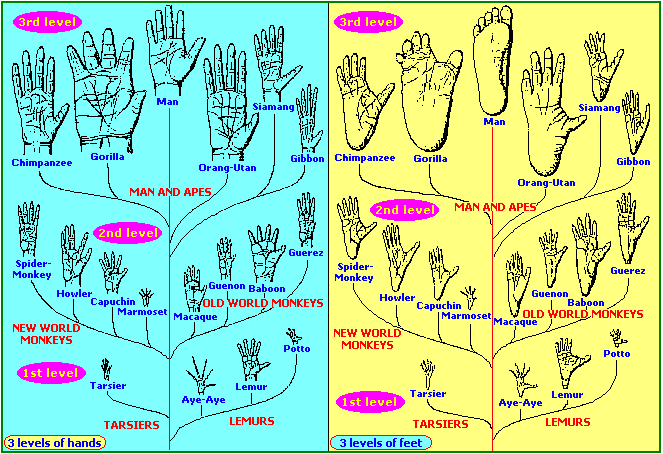
--- Primate Anatomy Comparisons ---
http://members.door.net/hominidartwork/compfthdst.htm
3 pollen zones are recognized from the late Pleistocene and Holocene record of the Laguna de Las Trancas, northern coastal Santa Cruz County, California region:
The deepest (earliest) zone, dominated by pine species and tentatively occurring 30,000–24,000 years B.P. (i.e., before present).
The pine-fir zone, 24,000–12,000 years B.P.
The redwood zone, perhaps 12,000–5,000 years B.P.
(In the latter zone, pine was virtually absent, redwood was apparently dominant on the more mesic sites, and the drier sites were open grassland.)Adam, D.P., R. Byrne, and E. Luther. 1981.
3 to 1 ratio of evolutionary forces by which Genes are thought to evolve:
- 1 of 3. Migration
- 2 of 3. Drift or Chance
- 3 of 3. Selection (often partitioned into natural selection and sexual selection).
- 1 of 1. Mutation (the original source of all genetic variation).
3 commonly occurring concepts used in discussions concerning adaptation:
Constraint- Constraints limit the phenotypic outcomes of selection. A constraint opposes the modifying influence of a selective force on the phenotype (The visible characteristics of an organism). In the absence of constraints, directional selection will continuously modify the phenotype over evolutionary time and there will be no stable phenotypic outcome of the selective process.
Spandrel- (Word coined by Daniel Dennett and appeared in his book "Darwin's Dangerous Idea," in which he discusses the concept of "spandrels" in evolutionary thought. A spandrel is in some respects considered an accidental byproduct of some other characteristic considered to be of more adaptive significance. The spandrel may at some point become an adaptation itself even though it did not begin as one.
Exaptation- (Formerly called preadaptation.) A trait that initially evolves as an adaptation for a particular effect, and then subsequently becomes exapted to another effect (Word and definition coined by S. J. Gould, & E. S. Vrba, (1982) Exaptation: A missing term in the science of form.) For example, feathers may have evolved initially for their insulation properties rather than for flight. Nevertheless, many of the feathers on a bird (such as wing and tail feathers) have been modified specifically for flight and so represent at least secondary adaptation for flight. Other feathers on a bird do not exhibit obvious modification for flight.
| 1. Via Genetic
Adaptation: Genes ¯ Behavior ¯ Fitness Consequences ¯ Natural Selection ¯ Increase in Fitter Genes |
2. Via Learning
Biases: Genes ¯ Learning Biases ¯ Evaluation of Consequences ¯ Persistence Of Rewarding Choices |
3. Via Cultural
Evolution: "Memes" (Cultural Variants) ¯ Behavior ¯ Fitness Consequences ¯ Natural Selection ¯ Increase in Fitter Memes |
http://courses.washington.edu/anth457/3typadap.htm
Alfred Russel Wallace, the codiscoverer of the theory of natural selection, felt the evidence showed that some metaphysical force had directed evolution at three different points:
- The beginning of life.
- The beginning of consciousness.
- The beginning of civilized culture.
http://members.shaw.ca/competitivenessofnations/Anno%20Jaynes%20Bicameral%20Mind1.htm
Unfortunately, far too many chest thumping religious zealots attribute the words "metaphysical force" as being one or more gods. Like so many ancient peoples whose minds could not grasp that their own individual inability to understand something did not/does not automatically equate with an act of some super-natural act of some being that requires humanity to be servile to it or them.
Herb O. Buckland
herbobuckland@hotmail.com